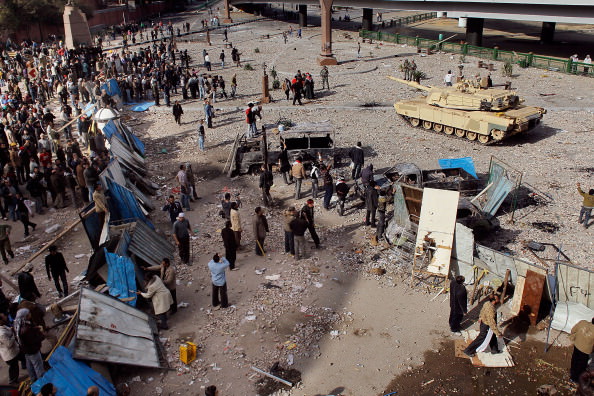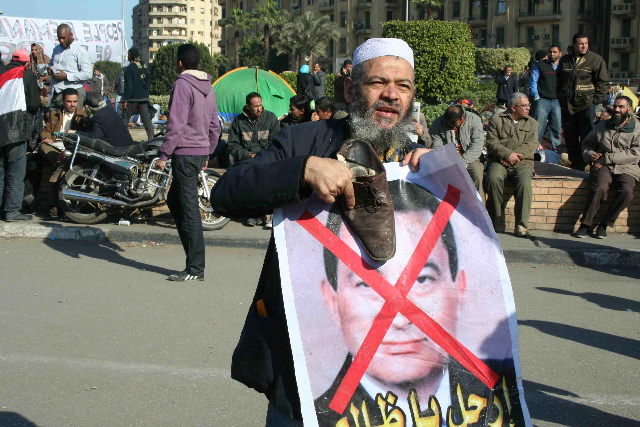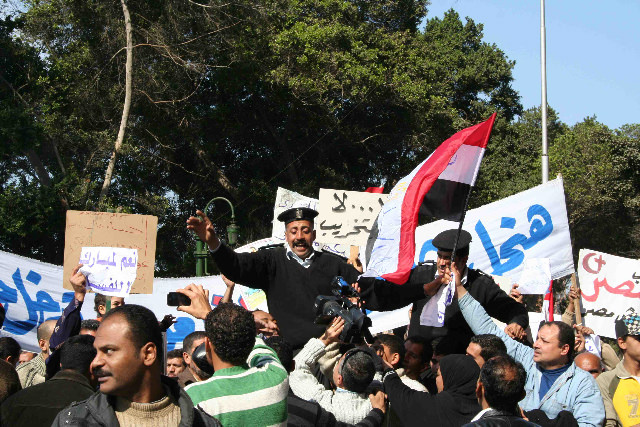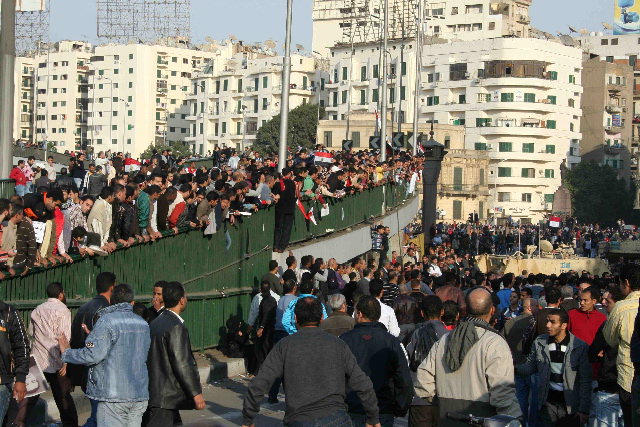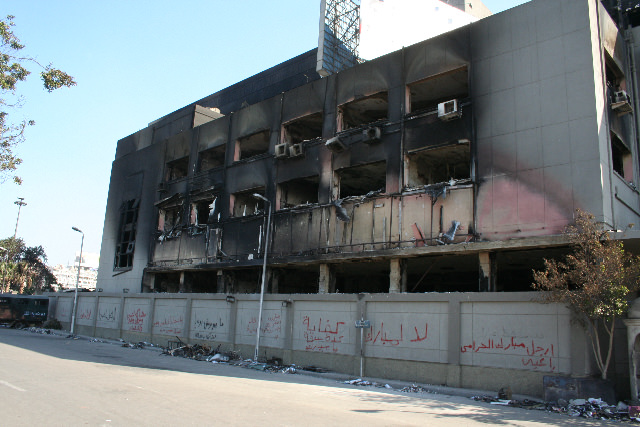On Tuesday, February 1, we headed to Tahrir Square for the “million man” march with some apprehension. After a week of growing protests, the military, which had arrived on Friday, had increased its presence in downtown Cairo, and the perimeter of the square was now completely barricaded with concrete blocks and metal barriers. Just two narrow entryways had been left—each manned by a dozen soldiers and just as many civilian volunteers. Despite the soldiers’ promise not to use force, many of us who entered the square wondered if they would trap us inside, and then, perhaps even shoot. By 4 PM however—well after the 3 PM curfew set by the military—we knew no harm would come, and the protest turned into something of a festival.
The army and the protesters worked together to weed out infiltrators trying to stir up trouble, and the crowd began chanting about the people and army being one. Estimates of the turnout varied, from one million to three. There was barely an empty square foot in the entire square and adjoining streets; people sang, played cards, shared meals, and later in the evening, began to talk of holding a soccer tournament, together with the army. One Al Jazeera correspondent compared it to a rock concert. People spoke of feeling pride at being Egyptian, some of them for the first time in their lives.
There were still a few thousand people in Tahrir Square early Wednesday morning—mostly men, who had remained following Tuesday’s march. I had gone home Tuesday night after spending the day there, and my plan now was simply to drop by early to get a feel for the “morning after.” When I arrived at the square, I was checked thoroughly by four soldiers and five civilian volunteers—three men and two veiled women. They searched my bag, gave me a pat down to insure I was not carrying a weapon, and asked for my ID. Eventually I was waved in, with a stern warning that any form of violence or incitement would not be tolerated.
Many were still sleeping when I got there, just after 8 AM: some on the grass with blankets over them; others in blue nylon camping tents. A few were at the foot of the sand-colored army tanks that had been stationed around the square and were now covered with anti-Mubarak graffiti. In scattered corners, hundreds of others were having breakfast and had already resumed chanting for Mubarak to leave—taking turns at loudspeakers to come up with inventive new slogans. In one corner, by a metro stop that has been closed for a week now, a gathering of 400 protesters recited poetry—their own, against the current regime. “Mubarak, Mubarak,” one of them repeated, “what have you done, look at the country, where art thou?”
Intermittently, two young men who referred to themselves as “The Organizing Committee”—self-appointed civilians who had already spent several nights in the square would take the mike, and with husky voices, tired from days of chanting, call on the crowds to make this ninth day of protest another peaceful one. No fighting, no arguing, and no tension—even if provoked. “We are here as one. We are having a good time. We are well fed and we are united—young, old, Christian, Muslim, men, women. We are simply Egyptians, and we want to show the world what the Egyptian people are all about—peace and unity.”
People were clapping, beating on drums, and singing along to rhyming anti-Mubarak jokes and refrains. (One dark one was about having to flee the country: “Egyptair, Egyptair, business is good, Mubarak’s staying, so we all need flights.”) A few portable radios were on, tuned to the news or playing popular Egyptian songs. Men and women were entering the square with bags filled with food—breadsticks, packets of wafer biscuits, cartons of mango and guava juice. I recognized one of the women, a historian and collector, carrying bottles of Nestle water. Nearby, two young boys selling biscuits were arguing about how to divide their profits. A man nudged my shoulder, noticing my camera. Pointing to the picture of Mubarak strapped around his neck and marked with a red X, he took off his shoe, placed it on the president’s head, and asked me to photograph him.
One man called on the president to step down soon: “Please, my arm is aching from holding up this sign,” he said.
I circled Tahrir for awhile, chatting with protesters who in some cases had been there for three or four days. “If Mubarak does not leave, I will die on Tahrir’s soil,” one man shouted in my ear, wagging his finger, then pointing up to the circling military helicopter overhead, waving it to go away. “Take Mubarak with you, take Mubarak with you,” the crowds shouted as it circled lower and closer, observing them.
Advertisement
No one was satisfied with Mubarak’s address to the nation the night before, in which he’d promised not to run in the September presidential elections, and the general sentiment was that it was too little too late. Those gathered were already planning ahead for more nights in Tahrir, and for this week’s Friday prayer, discussing who would lead the sermon in the square and where exactly that imam—or civilian—would stand. Mubarak had said in his speech that he would die on Egyptian soil; many of the people I talked to said they were prepared to die in Tahrir Square if he didn’t yield.
When I left mid-morning, I began to sense that the day might take a turn for the worse. As I passed two army tanks that were blocking one of the roads I saw a shrieking woman in a purple veil take on a group of thirty protesters. “You are ruining our country,” she yelled. “We had peace for thirty years, and in one week you have brought us to war. Mubarak is good. Mubarak is the best.” From a distance, the Organizing Committee called for the argument to be broken up. A young man in a green ‘Brazil’ hoodie and black jeans jumped to the cause, taking the woman’s arm and asking her to calm down. He escorted her out of the square, and a human shield formed to prevent her from charging in again. “What is happening,” someone’s voice echoed through a loud speaker, “is that NDP people”—i.e. from Mubarak’s party—“are trying to infiltrate the crowds and cause conflict. We will not allow that. We respect everyone’s opinions, but for those who are pro-Mubarak, there are hundreds of other squares around the city for you to occupy—this one though, is ours.” The voice then called on a group of two hundred men to block a far passage into the square where pro-Mubarak protesters were rumoured to be approaching.
I turned around, and noticed the speaker point up to the monolithic building—the government’s administrative center known as the mugamma—to his left. He asked the crowd to follow his finger, directed up at a corner of the roof. “YOU!” he shouted. “Yes you, in the dark glasses who we have seen every day spy on us from above. You can go back and report to the president that we are not going anywhere, until he does.” The crowd roared in applause. The mugamma has been closed for days now, shielded by the military, patrolled by soldiers.
As I exited Tahrir, I noticed the pro-Mubarak crowds beginning to gather. Two hundred of them stood at one of the main entry passages chanting against the opposition figure Mohamed ElBaradei, calling him a traitor and spy. They heckled protesters entering the square in a similar way, trying to provoke a confrontation. After lingering a little, they followed me down the Corniche in the direction of a rally, past the charred remains of the NDP headquarters, which had been burned over the weekend, past rows of tanks and soldiers, and on to the State TV and Radio building, where several hundred more pro-Mubarak protesters were already congregated, blasting the national anthem. There were some women among them—one in a wheelchair, fuming, at what had become of the city—but mainly men: some teachers, some white-collar employees, and scores of lower-middle class men in their twenties.
My notebook gave me away, and they surrounded me—dozens of them—roughly demanding that I take notes and report their accusations against the Tahrir protesters. I was pushed and shoved and someone spit in my face. Some of those around me seemed to have switched sides, moved by the president’s Tuesday speech. “Please write,” one man in his forties ordered me in broken English, tapping his finger forcefully on my notebook. “Mubarak, I am sorry. Please, forgive me. I am sorry.” Others wanted me to document their conspiracy theories: In particular, that the Muslim Brotherhood is funded by Iran, and that ElBaradei, who is known to have a villa in Austria and thought to have made a relative fortune from his IAEA post, pays anti-Mubarak protesters LE50 (about $9) a day to stay in the square. “And they get free KFC,” one urged me to add. “And it’s LE200 not LE50.”
The pro-Mubarak crowd seemed tense, on the verge of rioting. Among them, I also spotted a dozen uniformed police—the same ones who had vanished from the streets after Friday’s protests—now cheering, dancing, being carried on people’s shoulders wielding pro-Mubarak signs. One of them looked wearily at me as I pointed my camera up at him. He seemed to direct a soldier to me, who checked my journalist’s card and gave me the ‘OK’ to go ahead with my work.
Advertisement
I managed to move away from the crowd, and as I walked home, I called a friend who hadn’t yet been to the square that morning—Elijah Zarwan of the International Crisis Group—telling him it felt like clashes were imminent. Newscasters on State TV, perhaps knowingly, had already issued warnings that violence could erupt and urged citizens to stay home.
At 11:46 AM the government restored Internet access—it had been blocked for six days, since midnight on Thursday—and warnings about violence were circulating there too—on Facebook posts and Twitter feeds. We had all heard that pro-Mubarak protesters and thugs had been on the streets the night before, and an unofficial photocopied flyer had been circulating urging protesters to return home and accept Mubarak’s concessions. It appeared to be a warning—I was not sure from whom. Things seemed on the brink.
I had not been home for long before the first rocks were thrown in Tahrir Square around 2:30 PM. A friend called me immediately, reporting that he had been struck in the back by one. I got a cab and rushed back toward the square, hopping out amid thousands of pro-Mubarak protesters on one of the bridges that lead into it. There were children and families, but mainly tough-looking young men, shouting at their adversaries—some insults, some pro-Mubarak slogans, and many calls for them to get lost. The bridge was packed and from either side of it I could see hundreds, and then thousands, of pro-regime demonstrators marching in from different directions. There were reported to be thousands more approaching the city. In their midst, again, were police, chanting along. Some soldiers stood nearby, in a human chain, casually watching the protesters approach.
I hurried through the masses of people until I reached the Egyptian Museum, which faces Tahrir Square. There, some ten thousand pro-Mubarak protesters had gathered, and I noticed many of them were carrying thick, long, wooden sticks. I tried to push further toward the screaming I could hear coming from deeper in the square itself. I could also see smoke that looked much like the fumes of the tear gas the security forces had fired on us days before. In a split second things seemed to turn. The pro-Mubarak crowd in front of me lunged toward the protesters inside the square, hurling stones, picking up debris from the ground and throwing it into the air. I ran to the side of the bridge by the museum, just missing a horse that came galloping out from the crowds with a big man in his twenties. About a dozen more horses hurtled out. I also heard someone shout “camel.” It was a tactic we had never seen before.
Someone screamed at me to get out of the way. The barricades the army had put up ahead of Tuesday’s march seemed to have been cleared, and now the soldiers, who had been friendly with the protesters over the weekend, simply watched the pro-Mubarak demonstrators attack. I could hear piercing shrieks coming from further in the square. Pieces of metal and other debris seemed to be falling from the sky. Something seemed to be exploding, and I guessed it was shells of tear gas—it was a familiar sound. On the bridge above me, thousands of people had gathered to watch, standing on railings and shoulders. Men began to exit the crowds with their hands on their heads, covered in blood. People rushed in with tissues and water.
A man stared at me and asked where I was from, why I had a camera, what I was doing with a notebook. “Those filthy foreigners and their reports,” he said. I had heard that journalists were being harassed, and I quelled the instinct to panic. I lingered at the bottom of the bridge and called a friend who had been on the “anti-Mubarak” side of the square. He said there was still fighting and that he was stuck right in the center, unable to move. I wanted to tweet about the situation, and reached into my pocket for my phone. I had no chance—a round of gunfire went off just a few feet away. And then more. Successive shots. It sounded close—and as if someone in the pro-Mubarak crowd was aiming at the anti-Mubarak side of the square. People started to scream and run. A man pushed me forward, urging me to go up the bridge. A little boy tripped beside me, and his father grabbed him by his middle and fled.
I managed to get away, and found myself back near the State TV building, once again surrounded by pro-Mubarak demonstrators who had stationed themselves beneath Al Jazeera’s Cairo bureau next door, and were chanting messages up to its reporters. I raced through the crowd, apprehensive that they too might be armed. My speed may have given me away, and a group of young men pointed at me and started to shout “Spy! Traitor! Spy!” I panicked, and tried to disappear into the thick of the crowd, emerging a few minutes later with an Egyptian flag hoisted high—my “cover” bought for $2 from a young boy. Others in the crowd were holding flags, and it seemed to keep me safe. As I walked up another bridge, I passed trucks carrying gangs of thugs— the same type we had seen in the protests last week—being off-loaded onto the street. They had pro-Mubarak banners and were armed with wooden and metal sticks. I caught a glimpse of a knife stuck in the back of one man’s trousers. They saw my flag, and waved me on.
By Wednesday evening, many of my friends were among thousands stuck in Tahrir, which was still surrounded by pro-Mubarak armed men. Egypt’s Minister of Health had reported that five hundred people were injured and one killed in Wednesday’s afternoon violence—a figure he updated Thursday to eight deaths and 900 injuries. A friend—who saw it from an apartment overlooking the square—told me a fire had broken out on top of the Egyptian Museum. Activists were posting Facebook updates by the second, when possible identifying those hurt or detained, and making urgent pleas for help—for medical supplies and to transport injured protesters to hospitals. I heard that a journalist I knew had been severely wounded. The defence ministry was urging people to go home, and there were reports that armed men were circling Tahrir and fanning out across the city. In my neighborhood, the civilian patrols who have manned our streets for the past week (using passwords, changed daily, to admit residents) had been warned that the night would be rough.
At around 1 AM Thursday morning, there were reports of new gunfire and explosions in Tahrir. There was also shouting near my house, and someone was roaring into a loud speaker in the distance—I couldn’t make out what. I could hear explosions somewhere in the distance—perhaps across the river. A rumor spread that thugs would storm Tahrir at dawn. There were already flames in the square, and pro-Mubarak men were hurling Molotov cocktails and glass at protesters from a bridge. Reports of protesters who had gone missing—“kidnapped”—began to come in on social networking sites. Some activists and civilian volunteer patrols had managed to detain thugs and hand them over to the military. An activist tweeted, “We find that every thug arrested has ‘Police’ written on his ID. Those are the only pro-Mubarak protesters” Several confiscated police IDs were posted on the internet.
My father, who lives in another central Cairo neighborhood, called me early Thursday morning, warning of the escalating violence downtown. A friend of his who tried to make her way over one of the bridges to Tahrir around 6 AM had been stopped by armed thugs and warned to turn back if she cared for her life. I also learned that the 72-year-old father of a friend of mine had been hit by a stolen car filled with thugs in the middle of the night as he patrolled the streets with other civilians, and is now in an ICU. Reports of armed men around downtown were streaming in every minute.
Asked what it would do to quell the violence, the government only said, “we will invite, and re-invite, opposition parties to the negotiating table for discussions.” On State TV, which seemed to be broadcasting events from a parallel universe, the pro-Mubarak protesters were being depicted as “pro stability.” I got news that the deputy head of the Egyptian state channel Nile TV had resigned half way through the day—unable, she said, to feed the government’s lies. There was much talk, meanwhile, about who was behind the pro-regime mayhem. Even though some people attribute it broadly to the “government,” many believe it has perhaps been orchestrated by former minister of the interior Habib El Adly and leading members of the ruling National Democratic Party—in particular businessmen, who have benefited greatly from the regime. Among the NDP strongmen often mentioned is Ahmad Ezz, who is suspected by many of having manipulated and financed the rigged parliamentary elections in November. There had also been hired thugs out during those elections and the NDP is known to have unleashed hundreds of them to ensure victory.
Many people I am in touch with have been trying to get food and medical supplies into Tahrir since early Thursday morning, but most routes in are now blocked by thugs. “Everywhere I turn I find men with knives and guns,” a friend who was heading there by car with supplies told me at 9 AM. On Facebook, friends and activists are posting feeds: “5 of my journalist friends have been beaten and had their equipment confiscated. The pro-mubarak thugs are targeting journalists.” And another: “Friend was trying to deliver medical supplies, they smashed his car and he had to turn & run away #Jan25”. As gunshots and machine-gun fire are reported across the city, hospital workers describe overwhelming numbers of people coming in with concussions, internal bleedings, and third-degree burns. One activist tweets, “We’ve lost 10 Egyptians in the first gulf war in ’91 and 307 in our war with Mubarak. #egypt.”
Aida Seif El Dawla, the human rights activist who runs the downtown El Nadim Centre for victims of violence, has been posting news of kidnappings, injuries, and deaths. At 12:16 PM she writes, “Watching Mubarak’s terrorism first hand from the window. Officer supervising the violence.” At 4 PM a friend called from downtown. He was out of breath and panicking—he had just seen a group of thugs drag a foreign-looking man down the street, beating him, accusing him of being an Israeli spy.
Later in the day Aida Seif tweets: “Tomorrow, Anger Friday. Demonstrations all over Egypt chanting Mubarak OUT!”


